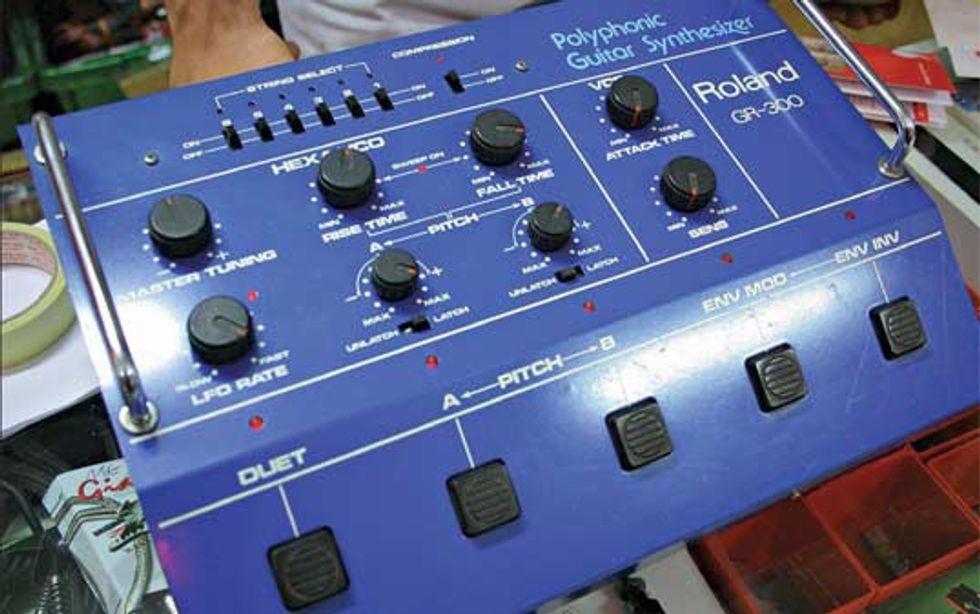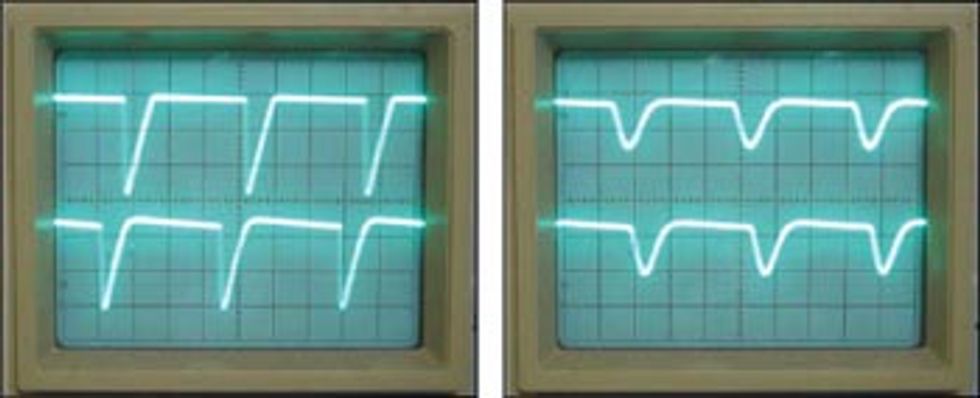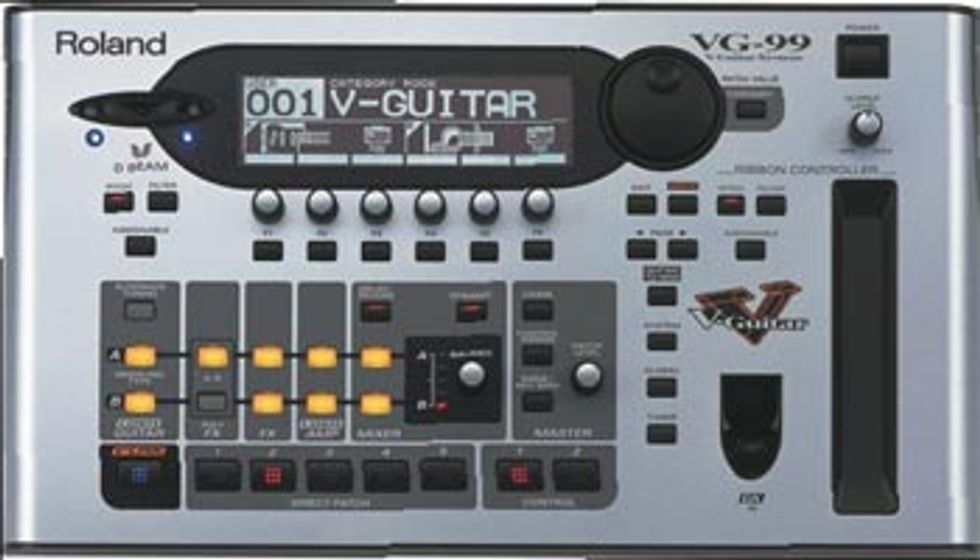 |
The Roland GR-300 holds a unique position in the world of guitar synths. While the sonic potential of the GR-300 was limited, its incredibly fast and accurate tracking made it the only guitar synthesizer to ever live up to the marketing hype. So naturally, Roland Corporation created quite a stir among guitar synth enthusiasts with the announcement that the new VG-99 would include a software emulation of the GR-300.
|
Recently, GR-300 modules have sold for close to $2000 on eBay, with complete systems featuring the G-303 controller selling for over $3000. This is well above the cost of a complete VG-99/FC-300/GK-3 rig, which made me wonder, would the VG-99/ GR-300 emulation compare with the original 1980 version?
What makes the GR-300 so special?
To appreciate the unique qualities of the GR- 300, let’s take a look at the unusual design of this early guitar synthesizer. Before the GR-300, most designers used a pitch-to-voltage circuit to generate a control voltage to drive a VCO, or voltage controlled oscillator. In other words, the guitar fretboard was basically substituting for a keyboard. This approach is much like today’s MIDI guitar synthesizers, which convert the pitch of a guitar string into a MIDI note.
The advantage of pitch-to-voltage systems, like pitch-to-MIDI systems, is that the guitar controller can be interfaced with similarly equipped gear. The ARP Avatar, for example, could be expanded with other ARP modules, or similar vintage synths. The GR-300 broke from this tradition, and used the output of the Roland hex pickup to directly drive the guitar synthesis process. It was a closed system, but what the GR-300 lacked in expansion and voicing options, it more than made up for in its remarkable ability to almost immediately translate fretboard actions into distinct synthesizer sounds.
While conventional analog synthesizers typically offer a variety of waveform outputs, the GR-300 has a unique sawtooth waveform not found on any other analog synthesizer. Because the cycle of the waveform from the hex pickup drives the synthesis process, Roland designers realized that lower notes would be much louder than higher notes. In fact, with each successive octave the waveform would lose half its amplitude. The solution was to simply chop off much of the top of the waveform, as this would keep all the notes at the same volume across the range of the guitar. This was certainly a brute-force approach, but this shifting sawtooth waveform gave the GR-300 a sound not found anywhere else. In the nineties, Roland sound designer Scott Summers sampled his own GR-300, and the unique GR-300 waveform started to show up in some new Roland guitar synthesizers. But sampling the GR-300 was clearly not the same experience as playing a GR-300.
Blue Box in a Silver Box
After much input from internet user groups, and perhaps after seeing the price of their venerable GR-300 soar in used gear markets, Roland promised to recreate the sound of the GR-300 inside the VG-99. Were they successful? Absolutely. After playing a GR-300 for years, it was quite disconcerting playing the VG-99/GR-300 emulation for the first time. The sound is all there, from the “spit” of the GR-300’s attack, to the characteristic breakup of the sawtooth waveform before the sound stops.
And Roland included all the features of a complete GR-300 rig, including pitch sweep controls, envelope filter modulation, LFO and even hex fuzz, a feature that was actually a part of the vintage guitar controller and not the GR-300 itself. When Roland claimed to completely emulate a GR-300 in the VG-99, they were serious. The new VG-99/ GR-300 has more creative options, along with the bells and whistles of modern technology: USB and coaxial digital outputs, and more effects than an entire eighties studio. For the critical tests, I plugged a Roland-Ready Fender Stratocaster into a converter/splitter so that I could play the VG-99 and GR-300 at the same time. Audio samples of these tests are available online, along with waveform photos and more info for the guitar geek.
 | |
|
When playing complex patches, the emulation of the GR-300 is virtually indistinguishable from the original. However, critically comparing the two synths side-by-side reveals a few minor flaws in the emulation. First, the waveform generated by the VG- 99 looks exactly like the diagram of the waveform found in the original Roland GR-300 patent application. But the actual GR-300 waveform lacks the crispness of the emulation, and has a very slight harmonic peak. Consequently, with the filters wide open on both synths, the VG-99 is perhaps a bit sharper and brighter in tone. However, once you start to close the -24 dB low pass filters down, the waveforms become nearly identical. Speaking of the filter, the emulation of the dramatic analog filter is also amazingly accurate, though the resonance is a bit more aggressive on the VG- 99 than it is on the original GR-300.
Emulating analog synthesizers in software actually presents some philosophical issues for designers. Do you slavishly recreate the sound of a 25-year-old synth, or do you recreate the sound of the synth as the original designers intended? And what is the sound of a GR-300? No doubt that after 25 years many of the components in my test GR-300 have lost their original electrical values. But since no one is building new GR-300s, this was the best test rig I could come up with.
Also of concern is the amplitude envelope. The decay of a sustained note using the VG- 99/GR-300 closely followed the actual decay of the unprocessed Strat sound. However, in the GR-300 the sound was a bit more compressed, holding at a fairly steady level before abruptly dropping off. The GR- 300, both real and emulated, does have a compression switch, but I had this turned off for these tests. For moderate to fast playing, you cannot hear the difference, but one of the pleasures of playing a GR-300 is hearing a low note sustain for twenty or thirty seconds before fading out. In the sustained audio samples, the VG-99/GR-300 always fades out before the original GR-300 does.
 | |
|
A minor note: the VG-99/GR-300 does not specifically mimic the “string select” feature found in the original GR-300. There are three modes of operation in the GR-300. Mode one is hex fuzz only, mode two is a combination of hex fuzz and synth sound, and mode three is synthesizer only. Pat Metheny, for example, only uses his GR-300 in mode three for lead voice. On the original GR-300 you can turn individual strings on and off, but only in mode three. The VG-99/GR-300 does not have this feature in the GR-300 section, but provides a way to switch individual strings on and off through the guitar modeling parameters.
The VG-99/GR-300 certainly recreates the analog fatness and vibe of the original GR-300. Perhaps Roland engineers had an advantage modeling the GR-300. Software emulations often suffer from being too perfect: the oscillators work too precisely, and the MIDI-based keyboard tracking generates perfectly intonated pitches. The VG-99/GR- 300 readily recreates the human quality of the original GR-300 synth, because any flaws in the Roland GK guitar controller are reproduced. The subtle difference between playing the same note on a wound or unwound string is heard, as is the inherent intonation compromises found in any guitar fretboard. It is these subtle differences that make the sound of the GR-300, real or virtual, more complex and interesting to the human ear than typical synthesizers. Unlike most synths, playing the same note twice does not create the exact same sound.
And now for Version 2.0?
My quibbles with the GR-300 emulation are really pretty small. For most GR-300 players, the VG-99 is well worth the money, since you can now keep your pricey vintage gear at home. Also, the VG-99 offers something the GR-300 never had: presets. Players pretty much had to stick to one sound, since there was no way to store and recall settings. Connect the FC-300 to the VG-99, and you can easily changes patches and recreate the octave shifts that are an essential part of the drama of any GR-300 solo. The VG-99 also lets the user assign more than one function to pressing a footswitch or moving a pedal. So hitting the CTL 1 switch can simultaneously change octaves, engage filter modulation and tweak the final output equalizer.
The VG-99 is software based, so there is always the possibility that Roland engineers will address the envelope issue in a future version, but even if that day never comes, I am truly impressed with the work that Roland put into the GR-300 emulation on the VG-99. Unlike most software vintage synthesizers that can exist solely in a CPU, the VG-99, like the GR-300, requires input from the real world to start its engines. And the dual-channel VG-99 will let you actually play two GR- 300s at the same time. Just try to track down the equivalent vintage gear to do that: two GR-300s, a super-rare Roland US-2 splitter, and three of the 24-pin cables. With prices steadily creeping higher and higher in the vintage market, you might be able to afford a new car for the same money!
With the VG-99 now providing my GR-300 tones, my elderly GR-300 is getting some well-deserved rest. Everything old, it seems, is new again.
Roland
rolandus.com/













